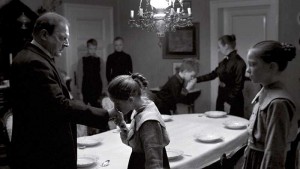 Step 1: Chalk up The White Ribbon as one of those German art films, in which the images are stark and minimalistic, the action languid and slow – and little to nothing is either revealed nor resolved. Coming from German auteur Michael Haneke (Funny Games, The Piano Teacher), it’s all very intellectual and thought-provoking and makes a statement about oppression and feudalism in a pre-WWI German village. But the film is also often maddeningly dull and puzzling for no apparent reason besides being self-indulgent art for art’s sake.
Step 1: Chalk up The White Ribbon as one of those German art films, in which the images are stark and minimalistic, the action languid and slow – and little to nothing is either revealed nor resolved. Coming from German auteur Michael Haneke (Funny Games, The Piano Teacher), it’s all very intellectual and thought-provoking and makes a statement about oppression and feudalism in a pre-WWI German village. But the film is also often maddeningly dull and puzzling for no apparent reason besides being self-indulgent art for art’s sake.
Step 2: Set the mood. The White Ribbon takes place in a small, rural village, in which a wealthy land Baron (Ulrich Tukur) employs over half the town to harvest his crops. There’s the hard-headed Steward (Josef Bierbichler), who tends to the grounds; the desperate Farmer (Branko Samarovski), who depends on the Baron for work; and then the other villagers who compose the other half, including the stern Pastor (Burghart Klaußner) and the lascivious Doctor (Rainer Bock). Each of these village men all have rather large families, with many children, and the film’s sadistic, central core comes from what happens to those children behind closed doors.
Step 3: Suffer the children. As narrated to us by the only seemingly kindhearted man in the village, the Schoolteacher (Christian Friedel), he describes a series of incidents one summer that set things in motion: The Doctor falls off his horse and breaks his collarbone after the animal is tripped by a thin wire; the Farmer’s wife dies when she falls through rotten floor boards on the Baron’s estate; the Baron’s only child is found beaten by a cane. Then, as Haneke peels back the layers, we begin to see what life is really like in this village, witnessing the abuse and the oppression, and watching how these creepy, Children of the Corn-looking kids may or may not be acting out.
Step 4: Wonder why nothing’s happening. Of course, writer/director Michael Haneke’s masterful craftsmanship is something to appreciate and admire, especially in his black-and-white vision with Ribbon. The imagery is both stunning and startling. Haneke also obviously gets a kick out of exploring humanity’s cruel nature, as evident in his other films, including Funny Games (maybe he has some issues to work out). There are moments in the film in which you feel something truly dreadful is going to happen, something will be resolved, but then nothing. Finally, at the end, the Schoolteacher tells us WWI has begun and bang, we’re out. Huh? Still, The White Ribbon is the type of film that picks up awards, so its recent Golden Globe win wasn’t surprising and neither would an Oscar win for Best Foreign Language.
Level of difficulty in watching The White Ribbon: Really hard. I’m just not the kind of movie watcher who enjoys being wrapped in existentialistic ennui – or in this case, existentialistic sadism – just for the sake of watching an art film. I left the theater, shaking my head, mumbling, “I sat through over two hours of this for nothing. I need to go take a nap.”

